Fountain Show at Burj Khalifa: A Dazzling Display
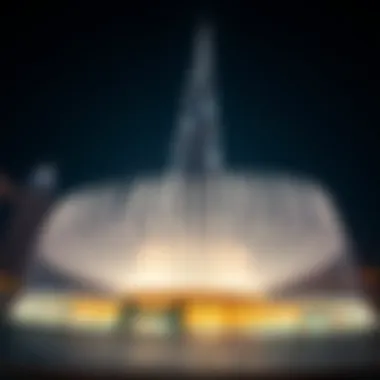
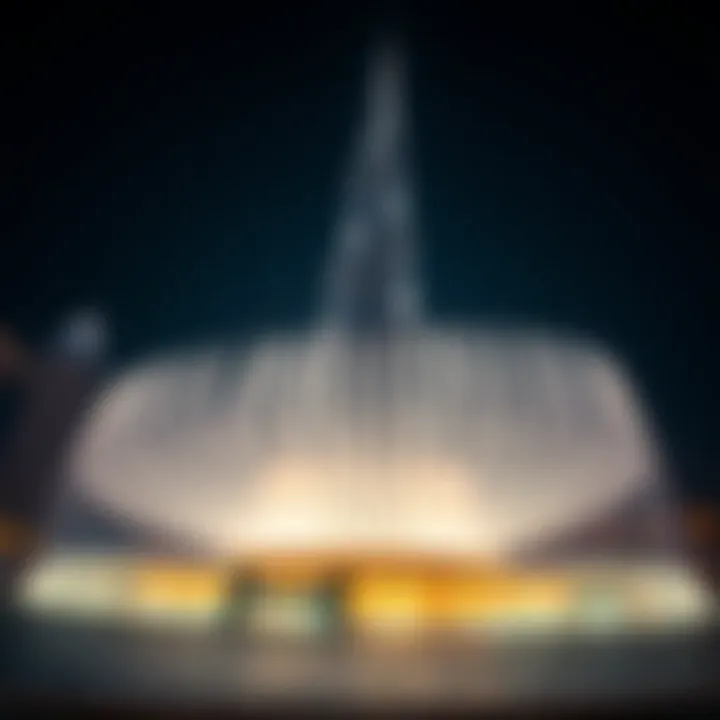
Intro
In the heart of Dubai, the Burj Khalifa stands as a monument to modern architecture and engineering prowess. Yet, just as captivating as the skyscraper itself is the mesmerizing fountain show that dances beneath it. The Burj Khalifa Fountain, the tallest performing fountain in the world, not only adds an enchanting element to the skyline but also plays a significant role in the cultural and economic framework of the city.
This fountain show is more than a simple spectacle; it is a symphony of water that flows in sync with music, complemented by its vibrant lighting. As we delve into the details of this remarkable attraction, we will explore how the fountain show enhances the experience of visitors and its considerable influence on Dubai’s real estate market.
With its intricate choreography, the show features a range of performances that can reach heights up to 150 meters, effortlessly captivating both tourists and locals alike. Exploring the relationship between this stunning display and the surrounding properties lays the groundwork for understanding its broader implications.
Throughout this article, we will engage in a thorough examination of the current market conditions around the Burj Khalifa area, discuss investment strategies for potential buyers, and reveal how the fountain show contributes to Dubai's various cultural narratives and real estate dynamics. \
By the end of our exploration, one should have a clearer understanding of how this exquisite attraction, set against the backdrop of the world's tallest building, not only enchants onlookers but also propels economic growth and investment potential within the region.
An Overview of the Burj Khalifa
The Burj Khalifa, standing tall at a staggering 828 meters, isn't merely a building; it's a symbol of ambition and innovation. To understand the fountain show that illuminates its base, one must first appreciate the intricacies that make this architectural marvel a focal point in Dubai’s skyline. This section delves into the historical context, architectural credentials, and the touristic lure of the Burj Khalifa, shedding light on why it plays such a pivotal role in shaping the identity of Dubai.
Historical Background
Constructed with the objective to diversify Dubai’s economy, the Burj Khalifa was designed by the renowned architectural firm, Skidmore, Owings & Merrill. The year 2004 marked the start of a journey that would redefine the boundaries of architecture. Initially named “Burj Dubai,” it was renamed in honor of Sheikh Khalifa bin Zayed Al Nahyan, the President of the United Arab Emirates, after financial support from the Abu Dhabi government helped complete the project in 2010.
From the outset, the Burj Khalifa was intended to act as a catalyst, attracting global attention and investment to the region. This intent is crucial, as it set the groundwork for the exponential growth of tourism and business in Dubai. High-profile events, like its grand opening, not only attracted international visitors but also marked the birth of new traditions and festivities around it, like the spectacular fountain show.
Architectural Significance
The architectural design of the Burj Khalifa is nothing short of a masterpiece. Inspired by Islamic architecture, its Y-shaped footprint draws influence from the desert flower, Hymenocallis. This innovative design allows for natural ventilation and maximizes views of the surrounding landscape. The building's exterior is adorned with reflective glass and polished stainless steel, merging modern technology with aesthetic values.
Notably, the Burj Khalifa has set several records, including the world's highest observation deck and the fastest elevators. These achievements symbolize the peak of engineering prowess and architectural imagination. Moreover, the tower’s construction employed cutting-edge methods, ensuring that its design could withstand the harsh demands of Dubai’s climate, from extreme heat to dusty winds.
Touristic Appeal
An undeniable draw for tourists, the Burj Khalifa serves as a hub of activity for millions annually. Visitors flock to its observation decks for sweeping views of the city and beyond, but the essence of the experience reaches its zenith with the fountain show that dances in the lake below.
The surrounding area abounds with attractions—such as the Dubai Mall, which is one of the largest shopping centers worldwide. Each evening, throngs gather to witness the fountains, which intricately choreographed to music, create a mesmerizing spectacle against the backdrop of an already breathtaking skyline. The blend of shopping, dining, and entertainment makes the Burj Khalifa not just a building, but a vital part of Dubai’s cultural and social fabric.
In essence, the Burj Khalifa is not only an architectural wonder but also a cornerstone of Dubai's identity as a global city.
Understanding these elements provides the foundational knowledge necessary for appreciating the fountain show, which is more than just a visual treat; it’s a reflection of the ethos that drives innovation in Dubai.
Understanding the Fountain Show
The fountain show at the Burj Khalifa represents more than just a display of water and lights; it is an essential element of Dubai's urban identity. Recognizing its significance can deepen one’s appreciation for this magnificent feat of engineering and artistry. This section delves into the show’s performance characteristics, the technical innovations that empower these stunning visuals, and the seamless fusion of sound and water.
Overview of the Performance
The fountain performance is a captivating spectacle, choreographed to a variety of music genres that range from classical to contemporary hits. Each performance lasts for about five minutes, featuring an amalgamation of high-pressure water jets that shoot up to 150 meters in the air, complemented by the dance of lights that dazzle spectators. The perfectly timed synchronization of water movements with the accompanying musical score is crucial, creating an immersive experience that enchants viewers. Visitors often find a sense of connection as they gather around the lakeshore, marveling at this dynamic interplay.
One unique aspect is the variation in performances, which are adapted to different occasions and holidays, making the show a flexible delight, catering not just to tourists but also to local culture, adding layers to its grandeur.
Technical Aspects
Water and Lighting Technology
Water and lighting technology plays a vital role in the fountain show, offering breathtaking visuals that captivate audiences. The power of high-tech nozzles enables water to shoot dramatically into the sky while intricate lighting systems accentuate every movement. This combination allows the fountain to transform depending on the music and theme of the performance.
Utilizing energy-efficient LED lights, the show can maintain stunning brightness while conserving energy, demonstrating a commitment to sustainable practices. This choice is not simply beneficial but practical, as it ensures long-term operation without excessive costs. Among its unique features, color-changing lights create mood shifts throughout the show, enhancing the narrative woven by the choreography. However, managing such advanced technology does require skilled technicians, making maintenance a consideration for long-term operation.
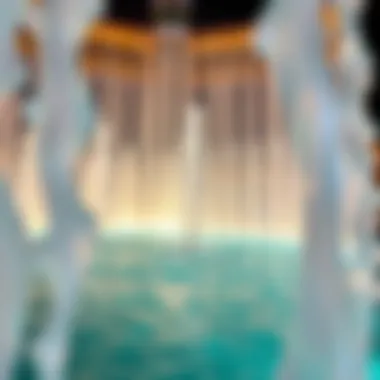

Control Systems
Control systems are the brains behind this spectacular fountain, orchestrating all elements in harmony. The central control unit manages not only the water jets but also the lights and music, ensuring a seamless presentation. This sophisticated setup is notable for its precision timing; it allows for micro-adjustments that can create nuances in the performances.
One key characteristic is its ability to pre-program performances based on time or event requirements, allowing for flexibility and spontaneity. This adaptability is a useful asset, especially during special events where unique shows might be needed. Nevertheless, reliance on technology raises concerns about technical failures, making regular maintenance and updates necessary to avoid disruptions in service.
Sound and Music Integration
Sound and music integration is a cornerstone of the fountain's allure, crafting a multi-sensory experience that engages spectators. The acoustics are thoughtfully designed, allowing music to resonate beautifully across the water’s surface. Each performance is matched to an eclectic soundtrack, from traditional Arabic melodies to popular Western hits.
This integration elevates each show's impact, tapping into emotional responses from the audience, ensuring that it's not merely a visual experience but a melodic journey as well. The highlight is the synchronization of sound with the water movements, which captivates viewers and encourages them to return for successive shows. However, ensuring sound quality across large crowds can be a challenge; technical expertise and sound engineers must work diligently to maintain clarity.
The fountain show at the Burj Khalifa is a testament to innovation, combining artistry with cutting-edge technology in ways that resonate with diverse audiences.
The interplay between these technical aspects not only constructs a visually arresting spectacle but also enriches the broader experience for visitors, yielding a strong draw for both tourists and locals alike.
For more information on the Burj Khalifa and its fountain, you can visit Wikipedia or check out Britannica.
As the fountain show continues to evolve, it shines as a central feature of Dubai's architectural landscape, attracting investment, tourism, and appreciation for its cultural value.
Cultural and Artistic Factors
The fountain show at Burj Khalifa is not merely a spectacle of lights and water; it serves as a canvas for the rich tapestry of Emirati culture and artistic expression. Exploring these cultural and artistic factors reveals how deeply intertwined the show is with the identity of Dubai and the broader United Arab Emirates. Visitors often do not recognize that behind the grandeur of the performance lies a narrative shaped by local heritage, creativity, and the pursuit of excellence.
Influence of Emirati Culture
The foundation of the fountain show’s design and execution reflects an intimate connection to Emirati culture. From its inception, the show has aimed to represent the spirit of the UAE. The way the water dances can evoke traditional art forms familiar in the region—the smooth, flowing motions echo the delicate patterns found in Islamic art.
One can observe how the stunning visual displays pay homage to the heritage of the UAE. Elements like waving palm trees and rippling desert dunes are mirrored in the movements of the water. This not only draws tourists in but also fosters a sense of national pride among locals. The architects and choreographers align the performance with significant cultural events and festivals, allowing the show to tell stories of unity, history, and aspiration. The balance between modernization and tradition is crucial, making the fountain a beacon of cultural significance.
Artistic Collaborations
Choreography
Choreography plays a pivotal role in bringing the fountain’s myriad performances to life. It is not simply the arrangement of movements, but a sophisticated synthesis of art and technology, designed to resonate with the audience emotionally. A key characteristic of the choreography is its alignment with the rhythm of the accompanying music. This synchronicity enhances the viewer's experience, allowing them to feel the eruption of emotion intertwined with the visuals.
One unique feature of the choreography is its ability to tell a story without words. Each performance can convey different themes, such as love, celebration, or nostalgia, through the fluid motion of water. This characteristic makes it a powerful, universal language that speaks to individuals from various backgrounds, which is beneficial for a diverse audience. However, the choreography must also contend with the technical challenges posed by water mechanics, requiring constant innovation and adaptation.
Music Selection
The selection of music is as important as the choreography itself in creating an immersive experience. Choosing the right soundscapes can elevate a visual performance into a memorable encounter. The music selection often draws from both traditional Arabic music and contemporary global hits, which resonates with a wide audience. This duality allows the show to cater to tourists seeking familiarity while simultaneously offering a taste of local culture.
A unique aspect of the music selection process is cooperation with renowned composers and musicians. Highlights include collaborations with artists like Andrea Bocelli and tracks that are curated specifically to match the emotional expression of each performance. However, navigating the balance between tradition and modern influence poses a nuanced challenge. While contemporary pieces might attract younger audiences, it’s crucial not to lose the essence and cultural richness that defines the UAE’s artistic narrative.
Thus, the artistic element of the fountain show encapsulates a socio-cultural dialogue, inviting visitors to engage not only with the spectacle but also with the narrative it conveys.
In summary, the cultural and artistic factors that influence the fountain show are not to be understated. They offer a multidimensional experience steeped in local tradition while embracing global elements. For investors and observers alike, understanding these components is key to appreciating the fountain as a living piece of art, echoing the values and aspirations of a nation.
Visitor Experience
The visitor experience at the Burj Khalifa fountain show is not just an event; it’s an immersive journey that leaves an imprint on those who witness it. This experience is pivotal to understanding its allure and how it intertwines with the broader context of Dubai as a tourist destination. Here, we’ll delve into facets like timing, prime viewing locations, and how these elements collectively enhance appreciation of the show.
Timing and Scheduling
Timing is critical when it comes to fully appreciating the fountain show. The performances typically occur in the evening, creating a spectacular visual contrast against the dark sky. This scheduling allows visitors to enjoy the lights in a setting that amplifies their charm. Shows commonly run every 30 minutes, starting at 6 PM, with a series of enchanting sequences cascading throughout the night.
One of the key benefits of precise scheduling is that visitors can easily plan their arrivals. Knowing when the next show is slated ensures that no moment is wasted. Moreover, during peak seasons, it’s often best to arrive early. Crowds can swell, making it a bit of a juggling act to find comfortable spots with unobstructed views.

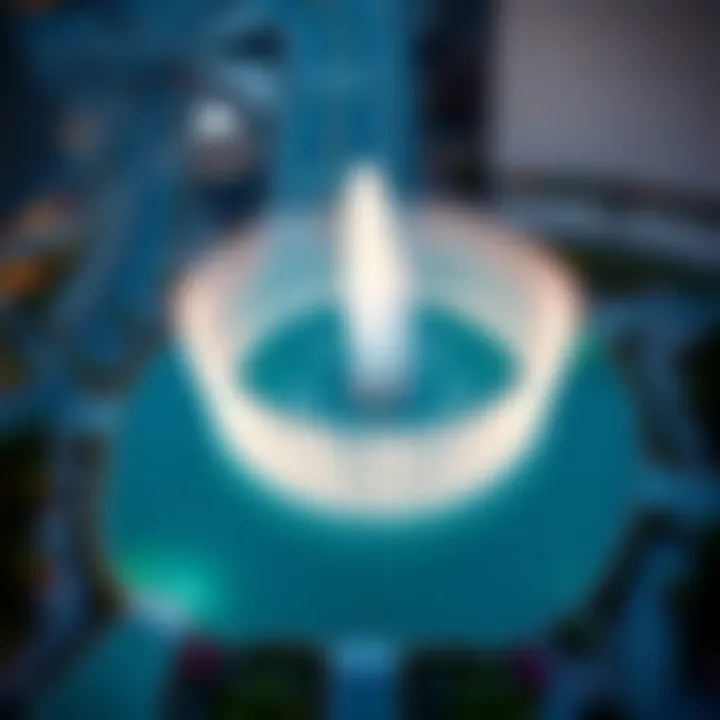
Viewing Locations
Best Spots for Spectators
Choosing the best spots for viewing the fountain show can significantly enhance the experience. One standout location is by the waterfront at the base of the Burj Khalifa itself. Here, the proximity to the fountain amplifies the visual impact of the show. Visitors can feel the splash of water and hear the music resonating in the air—a truly remarkable sensation.
Another notable area is the Dubai Mall, which has terraces that offer panoramic views of the fountain. While it may require a bit of a walk, the added backdrop of shopping and dining creates a leisure experience before and after witnessing the fountain show.
However, it’s worth mentioning a potential challenge—while these prime locations are the most popular, they often become crowded rather quickly. Arriving early can mean snagging a coveted front-row spot, but it also risks a lengthy wait.
Dining and Lounge Areas
Dining and lounge areas around the fountain enhance the evening considerably. Choices vary, from upscale restaurants with stunning views to casual cafes close to the action. Restaurants like Aubaine or At.mosphere offer not only superb cuisine but the chance to sip on a drink while viewing the show, thus elevating the experience to one of luxury.
The unique feature of these dining spots is that they provide a prelude and post-show atmosphere. Visitors can enjoy heartwarming conversations and sumptuous meals while awaiting the performance. Yet, be warned—the price tag can be a bit steep, reflecting both the ambiance and location.
"The real magic of the fountain show is not just what you see, but how it resonates within those who come to witness it."
For more insights into the Burj Khalifa and its stunning attractions, check out resources like Wikipedia and Britannica.
The experience at the fountain remains a kaleidoscope of sights and sounds, waiting to be appreciated by all who venture to this iconic landmark.
Economic Impact on the Surrounding Area
The fountain show at Burj Khalifa is more than just a spectacle of lights and water; it stands as a pivotal player in the economic landscape of Dubai. By creating a fusion of entertainment and tourism, this mesmerizing performance not only draws visitors from across the globe but also generates significant opportunities for local businesses and influences property values in its vicinity. It’s crucial to grasp the various layers at play regarding the fountain's economic impact on the surrounding area.
Boosting Local Business
Every evening, the crowds flock to the Burj Khalifa, and they aren’t just there to catch a glimpse of the fountains dancing under the stars. Local businesses thrive on this influx of tourists. Restaurants lined up with views of the fountain enjoy packed tables, with customers often willing to splurge on an unforgettable dining experience enhanced by the sights and sounds of the show.
Additionally, small vendors and souvenir shops see a surge in sales, offering everything from traditional Emirati crafts to high-end goods. The ripple effect can be profound, with increased foot traffic benefitting nearby hotels, transportation services, and even retail shops. This vibrant ecosystem not only nourishes existing businesses but encourages new ones to set up shop, creating jobs and enriching the local economy.
Influence on Property Values
Commercial Real Estate Trends
The commercial property market around the Burj Khalifa witnesses notable activity driven by the fountain show. The high exposure that retail spaces and office buildings enjoy makes them attractive investments. An essential aspect of commercial real estate here is its proximity to major attractions, which naturally ups the demand. Given that many businesses seek to leverage the appeal of the fountain show to attract clientele, properties with direct views or easy access to the fountains command higher prices. This phenomenon can lead to increased revenues for property owners, encouraging further development in the area.
Moreover, spaces that come equipped with innovative amenities or unique designs are especially sought-after, showcasing that modern aesthetics alongside strategic location are key characteristics of profitable commercial real estate ventures. This trend demonstrates a positive correlation between the fountain show and the real estate dynamics in the area, affirming that location remains king.
Residential Property Insights
On the residential front, living near the Burj Khalifa is often viewed as a luxury. The appeal of lifestyle associated with being close to such a renowned attraction results in a competitive housing market. Buyers and investors often consider properties with proximity to the fountain show desirable due to the vibrant atmosphere it creates. The ambiance generated by the nightly performances can enhance residents’ quality of life, leading to higher property prices.
However, this can also lead to challenges. The surge in demand may drive prices beyond what some buyers can afford, constraining options for local families. Nonetheless, early investors often find substantial returns on their investments due to the ongoing allure of the Burj Khalifa and the accompanying fountain show.
In summary, the fountain show at Burj Khalifa serves as a catalyst, impacting local businesses and undulating property values in significant ways. Its blend of artistic spectacle and economic function is vital in maintaining Dubai's status as a global tourism hub. Understanding these economic implications helps assess the fountain show’s true value beyond its visual appeal.
Tourism and the Fountain Show
The Burj Khalifa Fountain Show is not just a dazzling display of water and light; it is a significant catalyst for tourism in Dubai. The synergy between the fountain and its surroundings engages thousands of visitors every day, enhancing Dubai's profile as a key global tourist destination. With its unique design and execution, the show instills a sense of wonder, attracting tourists from around the world who wish to experience this stunning spectacle firsthand.
One cannot overlook the sheer scale of the fountain show. Stretching over 275 meters in length, it is designed to shoot water as high as 150 meters into the air. This magnificent sight doesn’t just fill the air with mist, it adds a layer of excitement to the overall tourist experience. Given that the Burj Khalifa itself is already a marvel, the fountain acts as an extension of this awe, creating an environment where visitors feel compelled to linger, often spending hours capturing photographs or simply absorbing the atmosphere.
Role in Attracting Tourists
The fountain show plays a pivotal role in Dubai's tourism strategy, drawing both local and international visitors. According to numerous reports, nearly 80% of those visiting the Burj Khalifa also make time to witness the fountain show. This statistic is no mere coincidence; the show is strategically scheduled to coincide with peak tourist hours, thus ensuring that it becomes an integral part of any Dubai itinerary.
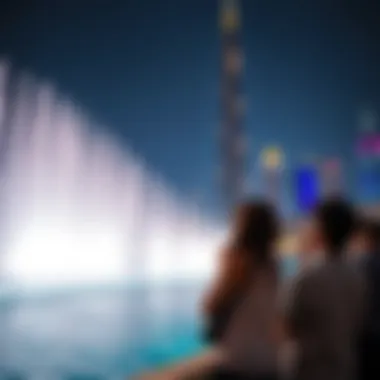
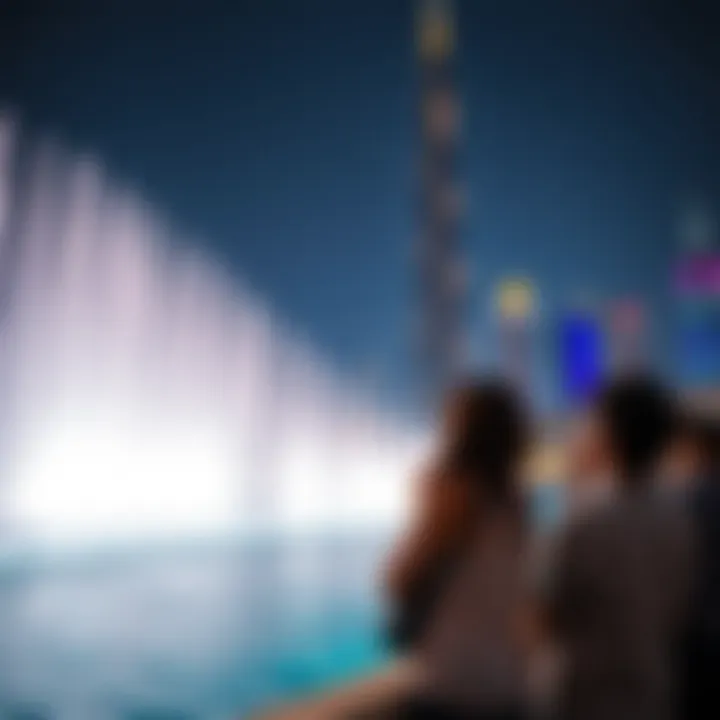
Several factors contribute to its tourist magnetism:
- Accessibility: Located at the base of the Burj Khalifa and surrounding the Dubai Mall, the fountain show is easily accessible, making it a convenient stop for tourists.
- Unique Alliances: Collaborations with international artists help craft an imaginative narrative, enchanting audiences and enhancing their overall experience.
- Cultural Immersion: The fountain shows feature a blend of traditional and contemporary music, often resonating with the diverse audience.
As the sun sets, the vibrant colors dancing among the water droplets transform the fountain into a surreal experience that is indeed Instagram-worthy. Tourists are often heard exclaiming in awe as the water choreography synchronizes with melodies, further cementing the show's draw. These moments encourage visitors to share their experiences on social media, amplifying the fountain show’s visibility and, in turn, its allure.
Events and Special Performances
Occasionally, the Burj Khalifa Fountain Show hosts special events that elevate the excitement factor. These events, which might include holiday-themed performances or musical collaborations with renowned artists, not only enhance the visitor experience but also provide opportunities for the tourism sector to promote the Burj region. For instance, during the New Year's Eve celebrations, the fountain show can become an elaborate centerpiece that draws in crowds exponentially larger than usual.
Special events create themed experiences that resonate with both locals and tourists:
- Holidays: During major holidays, such as Ramadan or National Day, the show might feature specific music that aligns with the occasion.
- Artistic Collaborations: Partnerships with global artists for unique performances enrich the tapestry of the fountain’s expressions, inviting a broader audience.
- Community Involvement: Events aimed at promoting local culture further cement the fountain show’s position as a cultural landmark.
Ultimately, the fountain show’s capability to pivot and evolve through events helps maintain its relevance, ensuring that tourists continue to find fresh reasons to revisit this spectacular display. As more people flock to Dubai, the show cements itself as a defining feature of the city, weaving it into the very fabric of Dubai’s tourism narrative.
Challenges and Considerations
Understanding the challenges faced by the fountain show at the Burj Khalifa is essential for grasping its complexity and sustainability. This section highlights two primary aspects of concern: maintenance and environmental impact. Each of these factors is vital, not just for the continued operation of the fountain, but for its reputation and contribution to the surrounding area as well.
Maintenance of the Fountain
The fountain system at Burj Khalifa is a marvel of engineering, boasting an impressive array of components that require consistent upkeep. Regular maintenance is crucial to ensure that the show operates smoothly and with maximum visual and auditory impact. The intricate network of pipes, pumps, and nozzles demands attention. Every drop of water needs to be choreographed to perfection, and malfunction could mean a less dazzling display.
Why Maintenance Matters
- Longevity of Equipment: Keeping machinery in good shape prolongs its life. That’s key for any investor looking for stable returns in properties nearby.
- Visitor Satisfaction: A well-maintained fountain leads to enhanced visitor experiences. People come to be awed, and any hiccup in performance can tarnish not just the show but also the reputation of the Burj Khalifa as a whole.
- Economic Implications: The fountain show significantly boosts local businesses. If maintenance lapses lead to reduced performances, nearby restaurants and shops may feel the pinch. After all, customers seek an all-rounded experience.
Routine inspections and repairs occur on a set schedule, often taking place during off-hours when potential audiences are sparse. This strategic planning minimizes disruption and ensures that the spectacle remains one of Dubai’s premier attractions.
Environmental Concerns
As impressive as the Burj Khalifa’s fountain is, it’s important to address the environmental considerations that come with operating such an extravagant display. The water used in the fountain, while visually stunning during shows, raises questions about sustainability.
Key Areas of Concern
- Water Usage: The fountain requires vast amounts of water, which raises eyebrows in a region where water scarcity can be a real issue. Understanding how the show recycles water is crucial for both environmental sustainability and public support.
- Energy Consumption: The technological feats behind the fountain show require substantial power. While innovative energy solutions are being explored, the show’s high energy demands might raise concerns about carbon footprints and overall sustainability.
- Impact on Local Wildlife: Activities in and around the fountain can disturb local ecosystems. Addressing these impacts is vital for maintaining a balanced relationship between progress and nature.
“In the push for grandeur, the environmental aspect cannot be overlooked. A balance must be found.”
Investors and locals alike should be aware of these considerations, as they reflect not only on the fountain show but also on the sustainability practices within Dubai as a whole. Awareness and proactive measures could shape the future of how such landmarks operate, paving the way for a greener approach to tourism.
By recognizing these challenges, investors can make informed decisions and contribute to solutions that enhance both the aesthetic allure of the fountain show and its environmental responsibility.
Future Prospects of the Fountain Show
The Burj Khalifa's fountain show stands out not just for its current allure but also for its forward-thinking prospects. As technology advances and visitor expectations evolve, the fountain show is bound to undergo significant transformations. Understanding these future prospects is crucial for investors, real estate agents, and tourism enthusiasts as they gauge the long-term viability of this remarkable attraction and its surrounding area.
Technological Innovations
In the realm of spectacular performances, incorporating technology is tantamount to staying relevant. With the advent of smart technology, we can anticipate that the Burj Khalifa’s fountain show will likely embrace cutting-edge innovations.
- Integration of AI: Utilizing artificial intelligence could revolutionize how the fountains synchronize with music or even respond to real-time audience reactions. Imagine the show adapting its choreography based on viewer engagement, providing a bespoke experience every night.
- Enhanced Lighting Techniques: As LED and projection technologies become increasingly sophisticated, the visual component of the fountain show could reach new heights. Utilizing micro-LEDs or holographic projections can add layers of depth and color, making the performance even more captivating.
- Sustainability Features: With environmental concerns louder than ever, innovations focused on sustainability can play an essential role. Water recycling systems or energy-efficient lighting could enhance the show while attracting eco-conscious visitors.
Expanding Visitor Engagement
To ensure the fountain show remains a must-see event, expanding visitor engagement will be central to its future. The more involved the audience feels, the higher the chances they return or recommend it to friends and family.
- Interactive Experiences: Future enhancements might involve interactive displays that allow visitors to better engage with the show. Perhaps through smartphone apps, audiences could vote on song selections or special effects, creating an interactive atmosphere.
- Thematic Nights: The introduction of themed shows could attract different demographics and encourage repeat visits. For instance, a cultural night featuring Emirati music or a holiday-themed display could diversify the offerings and keep the experience fresh.
- VIP Packages: Tailoring exclusive experiences, like behind-the-scenes tours or private viewing areas, could entice those looking to celebrate special occasions. Personalizing the experience can create loyal patrons who are likely to share their exciting memories online.
"The fountain show at Burj Khalifa is not just an attraction; it is an evolving embodiment of culture and technology that can redefine urban entertainment experiences."
Investing in these innovations and engagement strategies ensures the fountain show remains relevant in an ever-changing landscape. Through technological advancements and a focus on visitor interaction, the fountain show at Burj Khalifa is poised for a bright and promising future, adding value not just to the attraction itself but to the surrounding Dubai community.









